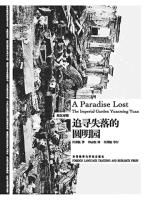Book Review
A Paradise Lost: The Imperial Garden Yuanming Yuan is a monograph written by Young-tsu Wong.In modern Chinese history, the Yuanming Yuan played a vital and complex role. On the one hand, it was a great masterpiece of the Qing dynasty which made the world feel so marvelous and earned the title of the Oriental Palace of Versailles ; on the other hand, it was its glory that made the western invaders selected it as a destruction objects. As a result, it becomes a symbol of modern China's history of humiliation. Young-tsu Wong, a Taiwan historian, seeing that western scholars know so little about it and the garden is also full of interest to him, wrote the book in the English detailing the history of the Yuanming Yuan. Although the book is written for Westerners, it has been translated into Chinese and published in the mainland because of its popularity. As the auction of some of the statues from a fountain of Yuanming Yuan aroused the nationalism of Chinese people, the book caused no small impact and is worthy to read.
The book is divided into two parts. The first chapter of the first part, provenance, explains the tradition of Chinese imperial gardens which, as an oriental architecture type, is different from the western castles, churches and palaces. After a long development, the noble could apply a well-established garden art in the building of their private gardens, especially in the south of China. It was the previous development of the garden art that made the appearance of Yuanming Yuan possible.
In the second chapter the author introduces the disposition of the famous landscapes and architectures in Yuanming Yuan. The Forty Views of Yuanming Yuan, each of which is with its own unique characteristics, were built by architects with painstaking effort. Many of them were copied from elsewhere under requirements from the emperor Qianlong, which made it a combination of the best landscapes of Chinese gardens. Moreover, Qianlong also expanded Yuanming Yuan, which is detailed in Chapter III. Firstly the construction of a new garden called Changchun Yuan, which is not only an appendage of Yuanming Yuan but a completely self-contained garden built for his own residence after retirement. In addition, the emperor also spent a large amount of money and materials building Xiyang Lou, Qichun Yuan and much more expansion of Yuanming Yuan. Such accounts about impress me greatly as the empire could finish such a wonderful job.
The second part is an added description of the previous history of Yuanming Yuan before Qianlong. Based on the ruin of Qinghua Yuan built by Li Wei during the Ming Dynasty,emperor Kangxi built his own imperial garden, the Changchun Yuan. He also built Yuanming Yuan ,which was not huge at first, and gave it to his fourth son, who was well known as the Yongzheng emperor later, as a present. Yongzheng expanded the garden, not only for recreational purposes, but also used as office space. Then ,during the reign of Qianlong ,the garden came to its golden age and once served as the reception of the famous British envoy George Macartney, the Netherlands and other envoys from another side of the globe. However, after that, the glorious history of Yuanming Yuan went towards to its end step by step.
Considering about our heavy heart, the authors uses the next few chapters to explain the structure and function of the landscape inside and the organization of its operation. He also introduces us the daily life of emperors who lived in Yuanming Yuan, such as Qianlong's schedule, the royal meals and entertainment. Yet such review of the brilliant history makes us feel more painful about the tragic destruction of the Yuanming Yuan.
The next section, the sacking, is about the history of humiliation that we Chinese people are quite familiar with but dislike mentioning. In 1860 the British and French forces invaded Beijing and ransacked the royal gardens.Soon, when the Qing government had agreed to surrender, the foreign invaders still tried to intimidate the Qing government further in order to force it to accept more conditions, so they burned the Yuanming Yuan. After that the foreign invaders did the same thing in 1900. The Qing government had no ability to completely rebuild Yuanming Yuan though the Empress Dowager Cixi rebuilt Qingyi Yuan and renamed it as Yihe Yuan ,the Summer Palace. As the government lost the control of the royal gardens, native bandits also joined in the destruction of Yuanming Yuan.Therefore, the brilliant garden was left in ruins, as the writer described in Chapter VIII about the repairs and the final blows in the description .
Since the Yuanming Yuan is a royal garden, to some extent, there is no significant relationship with ordinary people. However, reading this book still makes us feel deep sorrow, even if the readers have been already familiar with its tragic ending. That is because Yuanming Yuan is a symbol of Chinese art and achievements of Chinese civilization and its destruction symbolizes the status and fate of the whole Chinese civilization. Young-tsu Wong uses his words to lead us to face the glory and shame that Yuanming Yuan used to have while he seldom makes any comment, but showing us the facts. What he does is not to persuade us to accept his opinion but to show us the contrast and let us think and make judgments by ourselves. This is the value of this book.
What is more, it is worth mentioning that the author discusses The Yuanming Yuan ruins park at the end of book. He believes that as the new one is like but not equal to the original one, it could only do harm to our historical memory. The park is located in the city which now I live in and the debate about it is continuous. Perhaps Young-tsu Wong’s view could be enlightening.Perhaps Young-tsu Wong’s view could be enlightening.



 京公网安备 11010802032529号
京公网安备 11010802032529号